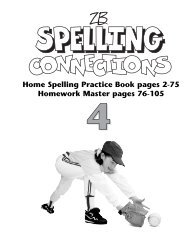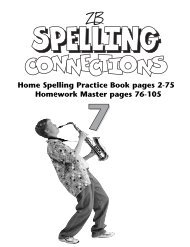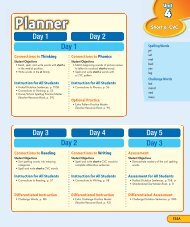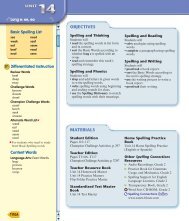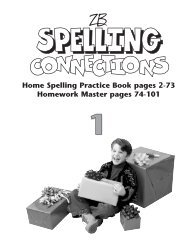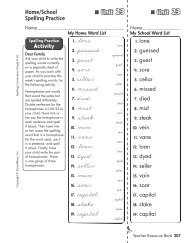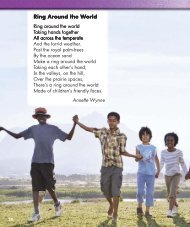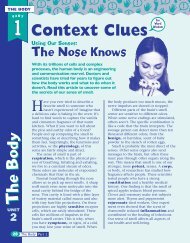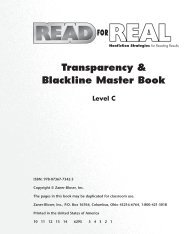Transparency & Blackline Master Book - Zaner-Bloser
Transparency & Blackline Master Book - Zaner-Bloser
Transparency & Blackline Master Book - Zaner-Bloser
Create successful ePaper yourself
Turn your PDF publications into a flip-book with our unique Google optimized e-Paper software.
<strong>Transparency</strong> &<br />
<strong>Blackline</strong> <strong>Master</strong> <strong>Book</strong><br />
ISBN: 978-07367-7344-7<br />
Copyright © <strong>Zaner</strong>-<strong>Bloser</strong>, Inc.<br />
FOR<br />
Level E<br />
The pages in this book may be duplicated for classroom use.<br />
Nonfiction Strategies for Reading Results<br />
<strong>Zaner</strong>-<strong>Bloser</strong>, Inc., P.O. Box 16764, Columbus, Ohio 43216-6764, 1-800-421-3018<br />
Printed in the United States of America<br />
10 11 12 13 14 6295 5 4 3 2 1
School to Home Letter<br />
Unit 1<br />
Practice the Strategy<br />
Scaffolded Web for Ghosts in the Twilight . . . . . . . . . . . . . . . . . . . .<strong>Transparency</strong> & BLM 1<br />
Answer Key<br />
Apply the Strategy<br />
Web for Hunters in the Shadows . . . . . . . . . . . . . . . . . . . . . . . . . . .<strong>Transparency</strong> & BLM 2<br />
Answer Key<br />
Unit 2<br />
Practice the Strategy<br />
Scaffolded Outline for The Mystery of Great Zimbabwe . . . . . . . . . .<strong>Transparency</strong> & BLM 3<br />
Answer Key<br />
Apply the Strategy<br />
Outline for A Story of the Anasazi . . . . . . . . . . . . . . . . . . . . . . . . . . .<strong>Transparency</strong> & BLM 4<br />
Answer Key<br />
Unit 3<br />
Practice the Strategy<br />
Scaffolded Comparison Matrix for A Game “Handed” Down . . . . . .<strong>Transparency</strong> & BLM 5<br />
Answer Key<br />
Apply the Strategy<br />
Comparison Matrix for A New/Old Way to Play Catch . . . . . . . . . . .<strong>Transparency</strong> & BLM 6<br />
Answer Key<br />
Unit 4<br />
Practice the Strategy<br />
Scaffolded Web for Many Lands, Many Breads . . . . . . . . . . . . . . . . .<strong>Transparency</strong> & BLM 7<br />
Answer Key<br />
Apply the Strategy<br />
Web for Foods From the Americas: A Shared Heritage . . . . . . . . . .<strong>Transparency</strong> & BLM 8<br />
Answer Key<br />
Unit 5<br />
Practice the Strategy<br />
Scaffolded Time Line for Earhart’s Adventures . . . . . . . . . . . . . . . . . .<strong>Transparency</strong> & BLM 9<br />
Answer Key<br />
Apply the Strategy<br />
Time Line for Pole Position . . . . . . . . . . . . . . . . . . . . . . . . . . . . . . . <strong>Transparency</strong> & BLM 10<br />
Answer Key<br />
Unit 6<br />
Practice the Strategy<br />
Table of Contents<br />
Scaffolded Spider Map for The Story of Stagecoach Mary . . . . . . . <strong>Transparency</strong> & BLM 11<br />
Answer Key<br />
Apply the Strategy<br />
Spider Map for Riding for the Pony Express . . . . . . . . . . . . . . . . . . <strong>Transparency</strong> & BLM 12<br />
Answer Key<br />
K-W-L Chart . . . . . . . . . . . . . . . . . . . . . . . . . . . . . . . . . . . . . . . . . . . . . <strong>Transparency</strong> & BLM 13<br />
Suggestions<br />
for<br />
Use<br />
Strategy Transfer Chart . . . . . . . . . . . . . . . . . . . . . . . . . . . . . . . . . . . . <strong>Transparency</strong> & BLM 14<br />
Suggestions<br />
for<br />
Use
Dear Family,<br />
School to Home<br />
Good reading comprehension is of vital importance to your son or daughter. Nonfiction<br />
textbooks in science, social studies, and math can be especially challenging. In addition,<br />
standardized tests demand that students read and understand quickly. Outside of the<br />
classroom, the challenge continues as students read magazines, newspapers, instructions,<br />
and other types of nonfiction material.<br />
Your child is currently using Read for Real: Nonfiction Strategies for Reading Results.<br />
This program teaches valuable reading comprehension strategies to help students become<br />
better nonfiction readers. Here is a list of the strategies and how they work:<br />
When to Use the Strategy What the Strategy Says What the Strategy Means<br />
Please discuss the strategies with your son or daughter while he/she is doing homework.<br />
You might even use some of the strategies as you and your child discuss television<br />
shows, movies, and newspaper or magazine articles.<br />
Thanks for your help!<br />
Sincerely,<br />
Before Reading<br />
During Reading<br />
After Reading<br />
Preview the Selection<br />
before you begin to read.<br />
Activate Prior Knowledge<br />
about the topic.<br />
Look at the pictures, headings, etc., to<br />
get an idea of what it will be about.<br />
Think about what you already<br />
know about the topic.<br />
Set a Purpose for reading. Decide what you want to learn as<br />
you read.<br />
Make Connections with<br />
what you are reading.<br />
Interact With the Text<br />
as you read.<br />
Clarify Understanding<br />
of what you are reading.<br />
Think about how your life and knowledge<br />
fit in with what you are reading.<br />
Ask and answer questions about<br />
what you’re reading.<br />
If something doesn’t make sense,<br />
look for clues to help it make sense.<br />
Recall what you just read. Try to remember key facts<br />
or ideas.<br />
Evaluate the selection. Decide whether the selection was<br />
based on facts.<br />
Respond to what you read. Form your own opinion about<br />
what you’ve read.
Copyright © <strong>Zaner</strong>-<strong>Bloser</strong>, Inc.<br />
Level E<br />
Unit<br />
1<br />
Practice<br />
controversy over<br />
gray and<br />
red wolves<br />
Scaffolded Web for<br />
Ghosts in the Twilight<br />
The Endangered<br />
Species List<br />
Ghosts in<br />
the Twilight<br />
Web<br />
number gets<br />
healthy, animal is<br />
delisted<br />
some species<br />
in serious trouble<br />
Questions About the<br />
Future of Wolves<br />
compromise is<br />
hoped for<br />
<strong>Transparency</strong> & BLM #1
Level E Scaffolded Web for<br />
Ghosts in the Twilight<br />
Unit<br />
1<br />
Practice<br />
protected<br />
by law<br />
decided by<br />
lawmakers<br />
controversy over<br />
gray and<br />
red wolves<br />
natural wolves<br />
completely<br />
protected<br />
The Endangered<br />
Species List<br />
What About<br />
Wolves?<br />
Possible Answers for<br />
<strong>Transparency</strong> & BLM #1<br />
plans made<br />
to protect the<br />
animal<br />
Ghosts in<br />
the Twilight<br />
in U.S., are<br />
endangered<br />
Web<br />
number gets<br />
healthy, animal is<br />
delisted<br />
people move<br />
and animals lose<br />
homes<br />
farmers and<br />
ranchers afraid<br />
Natural Versus<br />
Introduced<br />
Threatened,<br />
Endangered, Extinct<br />
controversy over<br />
which wolves are<br />
protected<br />
some species<br />
in trouble<br />
some species<br />
in serious trouble<br />
Questions About the<br />
Future of Wolves<br />
Canada, no<br />
wolves to return<br />
compromise is<br />
hoped for<br />
Copyright © <strong>Zaner</strong>-<strong>Bloser</strong>, Inc.
Copyright © <strong>Zaner</strong>-<strong>Bloser</strong>, Inc.<br />
Level E<br />
Unit<br />
1<br />
Apply<br />
Web for<br />
Hunters in the Shadows<br />
Web<br />
Hunters in<br />
the Shadows<br />
<strong>Transparency</strong> & BLM #2
Level E<br />
Unit<br />
1<br />
Apply<br />
no wolves in<br />
Yellowstone<br />
happy to restore<br />
the ecosystem<br />
For the Wolves<br />
keep wolves from<br />
becoming extinct<br />
Possible Answers for<br />
<strong>Transparency</strong> & BLM #2<br />
Web for<br />
Hunters in the Shadows<br />
helps biodiversity<br />
in park<br />
believe wolves<br />
should return on<br />
their own<br />
1995, wolves<br />
brought back<br />
Return of the<br />
Wolves<br />
make up for wolves<br />
killed in 1800s<br />
fear for safety<br />
of livestock<br />
Web<br />
Hunters in<br />
the Shadows<br />
Against the Wolves<br />
predators<br />
fear wolves would<br />
not stay in park<br />
Role of Wolves<br />
captured in<br />
Canada<br />
set free<br />
in park<br />
no wolves—<br />
ecosystem out of<br />
balance<br />
wolves help<br />
balance<br />
ecosystem<br />
kept near<br />
Yellowstone<br />
Wolf Arrivals<br />
fed carcasses<br />
Copyright © <strong>Zaner</strong>-<strong>Bloser</strong>, Inc.
Copyright © <strong>Zaner</strong>-<strong>Bloser</strong>, Inc.<br />
Level E<br />
Unit<br />
2<br />
Practice<br />
Scaffolded Outline for<br />
The Mystery of Great Zimbabwe<br />
Outline<br />
The Mystery of Great Zimbabwe<br />
I. Introduction<br />
A. Great Zimbabwe is ruins of an old capital city.<br />
B.<br />
C.<br />
II. Body<br />
A.<br />
B.<br />
C.<br />
1. The Great Enclosure had walls inside.<br />
2.<br />
3.<br />
4.<br />
5.<br />
1.<br />
2. Builders made a fire to heat the granite.<br />
3.<br />
4.<br />
5.<br />
1.<br />
2.<br />
3.<br />
4.<br />
5.<br />
6. The ruling class may have lived in the fortress.<br />
III. Conclusion<br />
A. No one knows what happened.<br />
B.<br />
C.<br />
<strong>Transparency</strong> & BLM #3
Level E<br />
Unit<br />
2<br />
Practice<br />
Possible Answers for<br />
<strong>Transparency</strong> & BLM #3<br />
Scaffolded Outline for<br />
The Mystery of Great Zimbabwe<br />
Outline<br />
The Mystery of Great Zimbabwe<br />
I. Introduction<br />
A. Great Zimbabwe is ruins of an old capital city.<br />
B. A great kingdom ruled southeast Africa from 1200 to 1450.<br />
C. All that’s left are granite walls and piles of stone.<br />
II. Body<br />
A. What was the Great Enclosure?<br />
1. The Great Enclosure had walls inside.<br />
2. The space was divided into different areas.<br />
3. It had a platform and a round tower with no doors or windows.<br />
4. Great Zimbabwe may have been a symbol for something.<br />
5. Builders also built houses of clay with grass roofs.<br />
B. How did they cook the stone?<br />
1. Huge granite rocks were nearby.<br />
2. Builders made a fire to heat the granite.<br />
3. They poured cold water on the hot rocks.<br />
4. Big, flat slabs of rock broke off.<br />
5. No one made bricks or dug rock out of the ground.<br />
C. What was the Hill Fortress?<br />
1. It was older and not as even as the Great Enclosure.<br />
2. Some areas may have been walled off.<br />
3. Early Shona people may have built it.<br />
4. The area was good for farming and herding.<br />
5. Local people controlled trade routes, which brought wealth.<br />
6. The ruling class may have lived in the fortress.<br />
III. Conclusion<br />
A. No one knows what happened.<br />
B. By about 500 years ago, the area was deserted.<br />
C. What happened is a mystery still to be solved.<br />
Copyright © <strong>Zaner</strong>-<strong>Bloser</strong>, Inc.
Copyright © <strong>Zaner</strong>-<strong>Bloser</strong>, Inc.<br />
Level E<br />
Unit<br />
2<br />
Apply<br />
I. Introduction<br />
A.<br />
B.<br />
C.<br />
II. Body<br />
A.<br />
1.<br />
2.<br />
3.<br />
4.<br />
B.<br />
1.<br />
2.<br />
3.<br />
4.<br />
5.<br />
6.<br />
C.<br />
1.<br />
2.<br />
3.<br />
D.<br />
1.<br />
2.<br />
3.<br />
4.<br />
5.<br />
6.<br />
III. Conclusion<br />
A.<br />
B.<br />
C.<br />
D.<br />
E.<br />
Outline for<br />
A Story of the Anasazi<br />
Outline<br />
A Story of the Anasazi<br />
<strong>Transparency</strong> & BLM #4
Level E<br />
Unit<br />
2<br />
Apply<br />
Possible Answers for<br />
<strong>Transparency</strong> & BLM #4<br />
Outline for<br />
A Story of the Anasazi<br />
Outline<br />
A Story of the Anasazi<br />
I. Introduction<br />
A. About 2,000 years ago, people lived in what is now the American Southwest.<br />
B. They hunted and gathered food there and took shelter in caves.<br />
C. They are called the Anasazi.<br />
II. Body<br />
A. What was “the pit house time”?<br />
1. By 700, the people were living in pit houses.<br />
2. Remains of these are still there on the mesas.<br />
3. People used a ladder to get in and out of their houses.<br />
4. No one knows why the people moved from the caves to the mesas.<br />
B. What were the early pueblos?<br />
1. Pueblos were one-room houses built like rows of apartments.<br />
2. They were built of sandstone bricks instead of sticks and mud.<br />
3. These Anasazi made a special kind of pottery.<br />
4. The people still climbed up to get down into their houses.<br />
5. Pit houses called kivas were religious centers.<br />
6. No written records exist.<br />
C. What were the later Pueblos?<br />
1. Chaco Canyon, in today’s New Mexico, was a busy Anasazi place.<br />
2. Pueblo Bonita is still standing.<br />
3. The Chaco Canyon pueblos are a mystery.<br />
D. Why did the Anasazi go back to the cliffs?<br />
1. The Anasazi were building cities and returning to the caves at the same time.<br />
2. Pueblos in the cliffs often were as large as the ones on the canyon floors.<br />
3. Cliff Palace at Mesa Verdi is a large cliff dwelling.<br />
4. Around 1100, the Anasazi stopped growing.<br />
5. By 1300, the dwellings and towns were empty.<br />
6. No one knows what happened.<br />
III. Conclusion<br />
A. Dryness in the area preserved Anasazi remains.<br />
B. In the late 1800s, a lot of people started going to the area to look for relics.<br />
C. Archaeologists first began to explore there in the early 1900s.<br />
D. What happened to the Anasazi is still a mystery.<br />
E. The missing voice is that of the Anasazi themselves.<br />
Copyright © <strong>Zaner</strong>-<strong>Bloser</strong>, Inc.
Copyright © <strong>Zaner</strong>-<strong>Bloser</strong>, Inc.<br />
Level E<br />
Unit<br />
3<br />
Practice<br />
equipment<br />
players<br />
rules<br />
Scaffolded Comparison Matrix for<br />
A Game “Handed” Down<br />
Comparison Matrix<br />
A Game “Handed” Down<br />
Early Hand Games Modern Hand Games<br />
• small, marked objects, such as<br />
animal bones; hollow bone and<br />
solid bone<br />
• small marked objects, often<br />
called “bones,” but really small,<br />
painted plastic or pottery<br />
cylinders<br />
• Drummer is always a man. • Many tribal colleges and<br />
universities hold competitions.<br />
• correct guess at location of<br />
marked object, get a wooden<br />
counting sticke ends.<br />
• Sometimes an umpire judges<br />
fairness.<br />
• First player hides objects, one in<br />
each hand.<br />
• Next player guesses which hand<br />
holds marked object.<br />
• Correct guess gets one point.<br />
• Wrong guess loses one point.<br />
• Or, first player hides one object<br />
and passes one to next teammate.<br />
<strong>Transparency</strong> & BLM #5
Level E<br />
Unit<br />
3<br />
Practice<br />
equipment<br />
players<br />
rules<br />
Possible Answers for<br />
<strong>Transparency</strong> & BLM #5<br />
Scaffolded Comparison Matrix for<br />
A Game “Handed” Down<br />
Comparison Matrix<br />
A Game “Handed” Down<br />
Early Hand Games Modern Hand Games<br />
• small, marked objects, such as<br />
animal bones; hollow bone and<br />
solid bone<br />
• one bone marked with leather<br />
strip around it<br />
• 2 players or 2 teams with the<br />
same number of players<br />
• Sometimes only men played.<br />
• Sometimes teams of women<br />
played each other.<br />
• Drummer is always a man.<br />
• correct guess at location of<br />
marked object, get a wooden<br />
counting stick<br />
• incorrect guess, lose a stick<br />
• When one player wins all the<br />
sticks, the game ends.<br />
• Winners may get prizes.<br />
• Sometimes an umpire judges<br />
fairness.<br />
• small marked objects, often<br />
called “bones,” but really small,<br />
painted plastic or pottery<br />
cylinders<br />
• smooth marked stones, buttons,<br />
or similar objects<br />
• many teams have own colors,<br />
jackets, songs, and fans<br />
• 2 players or 2 teams with the<br />
same number of players<br />
• Women and men both play.<br />
• Drummer is a man.<br />
• Many tribal colleges and<br />
universities hold competitions.<br />
• First player hides objects, one in<br />
each hand.<br />
• Next player guesses which hand<br />
holds marked object.<br />
• Correct guess gets one point.<br />
• Wrong guess loses one point.<br />
• Or, first player hides one object<br />
and passes one to next teammate.<br />
• Opponent guesses whether first<br />
player kept or passed marked<br />
object.<br />
• If wrong, play continues.<br />
• If right, opponent gets both<br />
objects and a turn to play.<br />
Copyright © <strong>Zaner</strong>-<strong>Bloser</strong>, Inc.
Copyright © <strong>Zaner</strong>-<strong>Bloser</strong>, Inc.<br />
Level E<br />
Unit<br />
3<br />
Apply<br />
Comparison Matrix for<br />
A New/Old Way to Play Catch<br />
Comparison Matrix<br />
A New/Old Way to Play Catch<br />
<strong>Transparency</strong> & BLM #6
Level E<br />
Unit<br />
3<br />
Apply<br />
equipment<br />
players<br />
rules<br />
Possible Answers for<br />
<strong>Transparency</strong> & BLM #6<br />
Comparison Matrix for<br />
A New/Old Way to Play Catch<br />
Comparison Matrix<br />
A New/Old Way to Play Catch<br />
Early Games Modern Games, Toys<br />
• In ring and pin, pin was thin<br />
pointed piece of bone, antler,<br />
or wood.<br />
• Ring was whatever was<br />
handy—piece of buffalo skin,<br />
bones with holes, dried squash<br />
rinds, etc.<br />
• The pin was connected to the<br />
ring with a piece of cord.<br />
• Everyone played—men, women,<br />
boys, and girls.<br />
• Players could play alone or<br />
with a partner.<br />
• Scoring differed by groups.<br />
• The more rings caught, the more<br />
points.<br />
• Holes in different places in ring<br />
counted for different points.<br />
• Play continued until one player<br />
earned 100 points, or whatever<br />
number was agreed to before<br />
play.<br />
• Kept score by passing sticks<br />
back and forth until one player<br />
had all the sticks.<br />
• handmade or store-bought<br />
ring and pin or toss and catch<br />
pieces<br />
• Anyone can play—alone, with a<br />
partner, or as a group.<br />
• Partners or group determine<br />
scoring before play begins.<br />
• First player plays for a set<br />
number of tries.<br />
• If successful, gets point.<br />
• If not, passes game pieces to next<br />
player.<br />
• First to reach set score is winner.<br />
Copyright © <strong>Zaner</strong>-<strong>Bloser</strong>, Inc.
Copyright © <strong>Zaner</strong>-<strong>Bloser</strong>, Inc.<br />
Level E<br />
Unit<br />
4<br />
Practice<br />
Scaffolded Web for<br />
Many Lands, Many Breads<br />
Ethiopia—<br />
Injera<br />
India—<br />
Chapati<br />
brush with ghee,<br />
use to pick up and<br />
eat other food<br />
Web<br />
hold spongy<br />
bread in hand and<br />
use to pick up<br />
other food<br />
Many Lands,<br />
Many Breads<br />
made with rye<br />
flour and other<br />
ingredients<br />
put dough in<br />
pan and bake<br />
cook in hot<br />
skillet or in oven<br />
<strong>Transparency</strong> & BLM #7
Level E<br />
Unit<br />
4<br />
Practice<br />
teff, water,<br />
and soda<br />
pour some batter<br />
in skillet, swirl, and<br />
cook quickly<br />
Possible Answers for<br />
<strong>Transparency</strong> & BLM #7<br />
Scaffolded Web for<br />
Many Lands, Many Breads<br />
Ethiopia—<br />
Injera<br />
roll into thin round<br />
pieces and place on<br />
hot griddle<br />
hold cooked piece<br />
over gas flame to<br />
puff up, and then<br />
flatten<br />
India—<br />
Chapati<br />
made with teff,<br />
a flour from millet<br />
brush with ghee,<br />
use to pick up and<br />
eat other food<br />
Web<br />
hold spongy<br />
bread in hand and<br />
use to pick up<br />
other food<br />
Many Lands,<br />
Many Breads<br />
made with wheat<br />
and white flours<br />
and water<br />
made with rye<br />
flour and other<br />
ingredients<br />
eat alone, with<br />
soup, or as<br />
sandwich<br />
eat alone, with<br />
soup, or with<br />
other foods<br />
Germany—<br />
Pumpernickel<br />
put dough in<br />
pan and bake<br />
mix cornmeal<br />
with other<br />
ingredients<br />
United States—<br />
Cornbread<br />
mix, knead,<br />
allow to rise<br />
cook in hot<br />
skillet or in oven<br />
Copyright © <strong>Zaner</strong>-<strong>Bloser</strong>, Inc.
Copyright © <strong>Zaner</strong>-<strong>Bloser</strong>, Inc.<br />
Level E<br />
Unit<br />
4<br />
Apply<br />
Web for<br />
Foods From the Americas:<br />
A Shared Heritage<br />
Web<br />
Foods From<br />
the Americas:<br />
A Shared Heritage<br />
<strong>Transparency</strong> & BLM #8
Level E<br />
Unit<br />
4<br />
Apply<br />
many sizes<br />
and colors<br />
one of few crops<br />
that would grow<br />
in Andes<br />
now spicy salsa<br />
often replacing<br />
ketchup<br />
many peppers grew<br />
in Americas and<br />
Caribbean<br />
Possible Answers for<br />
<strong>Transparency</strong> & BLM #8<br />
Web for<br />
Foods From the Americas:<br />
A Shared Heritage<br />
Potatoes<br />
once in Ireland, they<br />
grew well until a bad<br />
time in 1800s<br />
Europeans<br />
thought peppers<br />
too hot<br />
Peppers<br />
food crop of<br />
Incas in Peru<br />
Web<br />
today, eaten all<br />
over the world<br />
Many Irish came<br />
to U.S. and brought<br />
potato recipes. often eaten plain<br />
or as sauce or<br />
ketchup<br />
Foods From<br />
the Americas:<br />
A Shared Heritage<br />
most other<br />
peoples loved<br />
them<br />
immigrants<br />
brought peppers<br />
and recipes to U.S.<br />
Spanish found<br />
Aztecs eating<br />
“tomatl” in Mexico<br />
corn recipes<br />
come from all<br />
over world<br />
1,000 years ago,<br />
was food in all<br />
Americas<br />
in Europe, they<br />
were decorative<br />
plants<br />
Tomatoes<br />
corn on the cob,<br />
corn bread, tortilla,<br />
syrup<br />
Maize (corn)<br />
mix cornmeal<br />
with other<br />
ingredients<br />
grows more quickly<br />
than wheat<br />
Copyright © <strong>Zaner</strong>-<strong>Bloser</strong>, Inc.
Copyright © <strong>Zaner</strong>-<strong>Bloser</strong>, Inc.<br />
Level E<br />
Unit<br />
5<br />
Practice<br />
July 24, 1897<br />
1915<br />
during World War I<br />
1914–1918<br />
1928<br />
1929<br />
1930<br />
1932<br />
1933<br />
1935<br />
May 20, 1937<br />
July 2, 1937<br />
Scaffolded Time Line for<br />
Earhart’s Adventures<br />
Time Line<br />
Earhart’s Adventures<br />
first record: was first woman passenger across<br />
Atlantic Ocean<br />
also, first woman pilot to make solo round-trip across U.S.<br />
set women’s speed record<br />
first woman to fly solo across Atlantic<br />
<strong>Transparency</strong> & BLM #9
Level E<br />
Unit<br />
5<br />
Practice<br />
July 24, 1897<br />
Possible Answers for<br />
<strong>Transparency</strong> & BLM #9<br />
Scaffolded Time Line for<br />
Earhart’s Adventures<br />
1915<br />
during World War I<br />
1914–1918<br />
1928<br />
1929<br />
1930<br />
1932<br />
1933<br />
1935<br />
May 20, 1937<br />
July 2, 1937<br />
Time Line<br />
Earhart’s Adventures<br />
Amelia Earhart was born.<br />
graduated from a Chicago high school<br />
worked as nurse’s aide; began to dream of being a pilot<br />
first record: was first woman passenger across<br />
Atlantic Ocean<br />
also, first woman pilot to make solo round-trip across U.S.<br />
placed third in first Women’s Air Derby<br />
set women’s speed record<br />
first woman to fly solo across Atlantic<br />
broke her own transcontinental U.S. record<br />
first to fly over Pacific from Hawaii to California<br />
took off from Oakland, California, for around-the-world flight<br />
disappeared somewhere in the Pacific<br />
Copyright © <strong>Zaner</strong>-<strong>Bloser</strong>, Inc.
Copyright © <strong>Zaner</strong>-<strong>Bloser</strong>, Inc.<br />
Level E<br />
Unit<br />
5<br />
Apply<br />
Time Line for<br />
Pole Position<br />
Time Line<br />
Pole Position<br />
<strong>Transparency</strong> & BLM #10
Level E<br />
Unit<br />
5<br />
Apply<br />
Possible Answers for<br />
<strong>Transparency</strong> & BLM #10<br />
1872<br />
1894<br />
1896<br />
1911<br />
January, February, 1911<br />
October 11, 1911<br />
December 14, 1911<br />
January 30, 1912<br />
1928<br />
Time Line for<br />
Pole Position<br />
Time Line<br />
Pole Position<br />
Amundsen was born in Oslo, Norway.<br />
took first sea voyage in Arctic Sea<br />
made first long journey to the Antarctic<br />
His expedition arrived in Antarctica.<br />
set up base<br />
set out for South Pole<br />
arrived at South Pole<br />
left Antarctica<br />
died in plane crash at sea<br />
Copyright © <strong>Zaner</strong>-<strong>Bloser</strong>, Inc.
Copyright © <strong>Zaner</strong>-<strong>Bloser</strong>, Inc.<br />
Level E<br />
Unit<br />
6<br />
Practice<br />
born in Tennessee 1832<br />
Just Mary Fields<br />
Scaffolded Spider Map for<br />
The Story of Stagecoach Mary<br />
stayed in Toledo when Mother<br />
Amadeus moved to Montana<br />
got fired from mission<br />
after a shoot-out<br />
first African American<br />
woman to carry mail<br />
got her nickname<br />
The Story of<br />
Stagecoach Mary<br />
Spider Map<br />
in her 70s, opened laundry<br />
Stagecoach Mary’s Legend<br />
worked for St. Peter’s<br />
Mission for 8 years<br />
couldn’t stand cheaters<br />
town thought of her as<br />
a great woman<br />
<strong>Transparency</strong> & BLM #11
Level E<br />
Unit<br />
6<br />
Practice<br />
born in Tennessee 1832<br />
freed from slavery 1865<br />
went to Toledo, Ohio, 1881<br />
worked for Mother Amadeus<br />
Just Mary Fields<br />
Possible Answers for<br />
<strong>Transparency</strong> & BLM #11<br />
stayed in Toledo when Mother<br />
Amadeus moved to Montana<br />
accepted invitation and moved to<br />
Montana to work for mission<br />
Scaffolded Spider Map for<br />
The Story of Stagecoach Mary<br />
got fired from mission<br />
after a shoot-out<br />
restaurant failed<br />
started driving stagecoach<br />
for U.S. mail<br />
first African American<br />
woman to carry mail<br />
Stagecoach Mary at Last<br />
got her nickname<br />
The Story of<br />
Stagecoach Mary<br />
Spider Map<br />
drove supply wagon<br />
one night, wolves<br />
threatened horses<br />
Mary and the Wolves<br />
worked for St. Peter’s<br />
Mission for 8 years<br />
Mary fought back, saved supplies<br />
in her 70s, opened laundry<br />
Stagecoach Mary’s Legend<br />
couldn’t stand cheaters<br />
loved by people of Cascade<br />
free meals at hotel<br />
town rebuilt her burned laundry<br />
town thought of her as<br />
a great woman<br />
Copyright © <strong>Zaner</strong>-<strong>Bloser</strong>, Inc.
Copyright © <strong>Zaner</strong>-<strong>Bloser</strong>, Inc.<br />
Level E<br />
Unit<br />
6<br />
Apply<br />
Spider Map for<br />
Riding for the Pony Express<br />
Riding for the<br />
Pony Express<br />
Spider Map<br />
<strong>Transparency</strong> & BLM #12
Level E<br />
Unit<br />
6<br />
Apply<br />
George Little once<br />
delivered on foot<br />
Possible Answers for<br />
<strong>Transparency</strong> & BLM #12<br />
Spider Map for<br />
Riding for the Pony Express<br />
in 1860, no trains or telegraphs<br />
to Oregon and California<br />
in 1858, Congress paid stage<br />
company to carry mail west<br />
Need for News<br />
ran 24 hours a day<br />
did 2,000-mile route<br />
in 10 days or less<br />
riders became heroes<br />
Riding Into History<br />
2,800-mile trip took 3 weeks<br />
William Russell and partners<br />
thought of Pony Express<br />
idea in 1860<br />
faced many dangers<br />
one rider was Billy Cody<br />
Riding for the<br />
Pony Express<br />
Spider Map<br />
paid $200 for small,<br />
strong horses<br />
at western end, bought mustangs<br />
set up stables and stations<br />
along route<br />
Getting Started<br />
each rider to go 75 to 100 miles,<br />
changing horses 5 to 7 times<br />
first coast-to-coast<br />
telegram in 1861<br />
The End of the Ride<br />
Pony Express closed 2 days later<br />
company lost money,<br />
owners were broke<br />
chose small, brave riders<br />
started with 500 horses<br />
and 80 riders<br />
riders went 600,000 miles<br />
delivered 34,752 pieces of mail<br />
helped build the nation<br />
Copyright © <strong>Zaner</strong>-<strong>Bloser</strong>, Inc.
Copyright © <strong>Zaner</strong>-<strong>Bloser</strong>, Inc.<br />
K-W-L Chart<br />
K W L<br />
What I Know What I Want to Know What I Learned<br />
<strong>Transparency</strong> & BLM #13
How to Use a K-W-L Chart<br />
K-W-L is a teaching strategy that you can use with students<br />
• to activate prior knowledge about a topic.<br />
• to set purposes for reading a selection.<br />
• to organize what they learn as they read a selection.<br />
• to confirm or revise their original thoughts about the topic.<br />
The K-W-L strategy is used before, during, and after reading nonfiction text.<br />
Model the use of the K-W-L Chart by using the transparency as a whole-group<br />
activity. You may wish to have students use the blackline master to create their<br />
own K-W-L Charts.<br />
Follow these steps when you use a K-W-L Chart:<br />
1. Ask students to preview the reading selection.<br />
2. Have students brainstorm what they already know about the topic.<br />
Write (or have students write) their ideas in the K column of the<br />
chart (What I Know).<br />
3. Ask students to think of some things they would like to know about<br />
the topic. Have students put these into question form. Write<br />
(or have students write) their questions in the W column of the<br />
chart (What I Want to Know).<br />
4. Have students read the selection. As they read, they may generate<br />
additional questions for the W column; these questions may<br />
be added to the chart. Students can also begin to record new<br />
information in the L column (What I Learned).<br />
5. Ask students what they learned about the topic from their reading.<br />
Write (or have students write) this information in the L column.<br />
6. Ask students to look again at the K column to check their original<br />
ideas about the topic. Have students confirm or change each item.<br />
7. Ask students to check the W column to make sure all their questions<br />
have been answered.<br />
8. Discuss the completed K-W-L Chart. If additional information is<br />
needed to answer questions, you may wish to add another column<br />
labeled H (How Can I Find Out?).<br />
Note: K-W-L was developed by Donna Ogle (Ogle, D. [1986]. “K-W-L: A teaching<br />
model that develops active reading of expository text.” The Reading Teacher<br />
39, 564–570).
Copyright © <strong>Zaner</strong>-<strong>Bloser</strong>, Inc.<br />
Strategy Transfer Chart<br />
Name _____________________________________________________________<br />
Write the title of a selection you are reading in one of your other<br />
books. Review the strategies and check at least one strategy to use<br />
Before, During, and After reading.<br />
BEFORE READING<br />
Preview the<br />
Selection<br />
Activate Prior<br />
Knowledge<br />
Set a Purpose<br />
DURING READING<br />
Make<br />
Connections<br />
Interact<br />
With Text<br />
Clarify<br />
Understanding<br />
AFTER READING<br />
Recall<br />
Evaluate<br />
Respond<br />
Strategy<br />
by looking at the title and headings to predict what<br />
the selection will be about.<br />
by looking at the photographs, illustrations, captions, and<br />
graphics to predict what the selection will be about.<br />
by looking at the title, headings, pictures, and graphics<br />
to decide what I know about this topic.<br />
by reading the introduction and/or summary to decide<br />
what I know about this topic.<br />
by using the title and headings to write questions<br />
that I can answer while I am reading.<br />
by skimming the selection to decide what I want<br />
to know about this subject.<br />
Strategy<br />
by relating information that I already know about<br />
the subject to what I’m reading.<br />
by comparing my experiences with what I’m reading.<br />
by identifying the main idea and supporting details.<br />
by identifying how the text is organized (cause/effect; compare/<br />
contrast; problem/solution; question/answer; sequence of events).<br />
by using photographs, charts, and other graphics<br />
to help me understand what I’m reading.<br />
by deciding whether the information I’m reading<br />
is fact or opinion.<br />
Strategy<br />
by summarizing the selection in writing or out loud.<br />
by using the headings to question myself about what I read.<br />
by searching the selection to determine how the author used<br />
evidence to reach conclusions.<br />
by forming a judgment about whether the selection<br />
was objective or biased.<br />
by drawing logical conclusions about the topic.<br />
by forming my own opinion about what I’ve read.<br />
Title:<br />
Title:<br />
Title:<br />
Title:<br />
<strong>Transparency</strong> & BLM #14
How to Use the Strategy Transfer Chart<br />
Read for Real teaches students important comprehension strategies for<br />
nonfiction reading. Ultimately, however, these strategies are valuable only<br />
if students are able to transfer them to other reading materials.<br />
Students are required to read a variety of nonfiction, or informational, texts<br />
in school and out of school. Science and social studies textbooks are the most<br />
obvious in the school setting. Students also read newspaper, Internet, and<br />
magazine articles, essays, and speeches. Outside of school, students must<br />
read, understand, and apply information from charts, schedules, maps, game<br />
directions, instructions for repairs, warranties, recipes, job applications, and<br />
other types of forms.<br />
The Strategy Transfer Chart provides a way for students to practice using<br />
the Before, During, and After strategies in Read for Real with other reading<br />
materials. Use the transparency to model the use of the Strategy Transfer<br />
Chart as a whole-group activity with another piece of nonfiction, such as a<br />
magazine article or a chapter from a science or social studies book. Have<br />
students use the blackline master to begin their own Strategy Transfer Charts.<br />
Provide opportunities for students to regularly add to their charts when they<br />
read other nonfiction text.<br />
Here are more suggestions for using the Strategy Transfer Chart:<br />
• Enlarge the chart and post it in your classroom. Remind students<br />
to think about the strategies as they read other materials and to<br />
identify when they use a particular strategy.<br />
• Give the Strategy Transfer Chart to content area teachers who<br />
work with your students. Ask them to encourage students to use<br />
these strategies as they read.<br />
• Send the Strategy Transfer Chart to students’ families with the<br />
School to Home letter. Suggest that parents post the chart on<br />
the refrigerator or bulletin board. Encourage parents to find<br />
opportunities to discuss the strategies with their children—as<br />
the children do their homework, by reading and discussing<br />
newspaper and magazine articles together, and while watching<br />
television shows, movies, and newscasts.<br />
The real value of the strategies that students learn in Read for Real is the<br />
transfer of the strategies to other nonfiction reading that students do.





